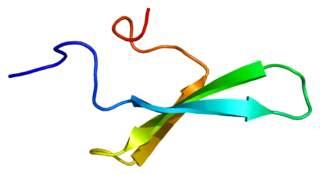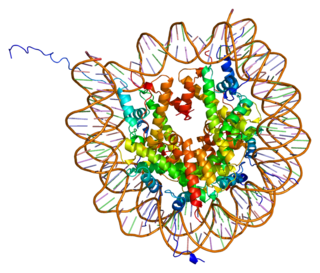In genetics, a transcription terminator is a section of nucleic acid sequence that marks the end of a gene or operon in genomic DNA during transcription. This sequence mediates transcriptional termination by providing signals in the newly synthesized transcript RNA that trigger processes which release the transcript RNA from the transcriptional complex. These processes include the direct interaction of the mRNA secondary structure with the complex and/or the indirect activities of recruited termination factors. Release of the transcriptional complex frees RNA polymerase and related transcriptional machinery to begin transcription of new mRNAs.

Exonucleases are enzymes that work by cleaving nucleotides one at a time from the end (exo) of a polynucleotide chain. A hydrolyzing reaction that breaks phosphodiester bonds at either the 3′ or the 5′ end occurs. Its close relative is the endonuclease, which cleaves phosphodiester bonds in the middle (endo) of a polynucleotide chain. Eukaryotes and prokaryotes have three types of exonucleases involved in the normal turnover of mRNA: 5′ to 3′ exonuclease (Xrn1), which is a dependent decapping protein; 3′ to 5′ exonuclease, an independent protein; and poly(A)-specific 3′ to 5′ exonuclease.

Transcription elongation regulator 1, also known as TCERG1, is a protein which in humans is encoded by the TCERG1 gene.

Three prime repair exonuclease 2 is an enzyme that in humans is encoded by the TREX2 gene.

Histone H2B type 1-L is a protein that in humans is encoded by the HIST1H2BL gene.

Probable helicase senataxin is an enzyme that in humans is encoded by the SETX gene.

Nuclear factor 1 C-type is a protein that in humans is encoded by the NFIC gene.

THO complex subunit 1 is a protein that in humans is encoded by the THOC1 gene.

Cleavage and polyadenylation specificity factor subunit 3 is a protein that in humans is encoded by the CPSF3 gene.

Mediator of RNA polymerase II transcription subunit 31 is a protein in humans encoded by the MED31 gene. It represents subunit Med31 of the Mediator complex. The family contains the Saccharomyces cerevisiae SOH1 homologues. SOH1 is responsible for the repression of temperature sensitive growth of the HPR1 mutant and has been found to be a component of the RNA polymerase II transcription complex. SOH1 not only interacts with factors involved in DNA repair, but transcription as well. Thus, the SOH1 protein may serve to couple these two processes.

Transcription termination factor 1 is a protein that in humans is encoded by the TTF1 gene.

Proprotein convertase subtilisin/kexin type 4 is an enzyme that in humans is encoded by the PCSK4 gene.

Repressor of RNA polymerase III transcription MAF1 homolog is a protein that in humans is encoded by the MAF1 gene.

DNA-directed RNA polymerase I subunit RPA34 is an enzyme that in humans is encoded by the CD3EAP gene.

DNA-directed RNA polymerase I subunit RPA1 is an enzyme that in humans is encoded by the POLR1A gene.

DNA-directed RNA polymerase III subunit RPC10 is an enzyme that in humans is encoded by the POLR3K gene.

Dimethyladenosine transferase 2; transcription factor B2, mitochondrial is an enzyme that in humans is encoded by the TFB2M gene.

Mediator of RNA polymerase II transcription subunit 16 is an enzyme that in humans is encoded by the MED16 gene.

DNA-directed RNA polymerase, mitochondrial is an enzyme that in humans is encoded by the POLRMT gene.

DNA-directed RNA polymerase III subunit RPC5 is an enzyme that in humans is encoded by the POLR3E gene.
















